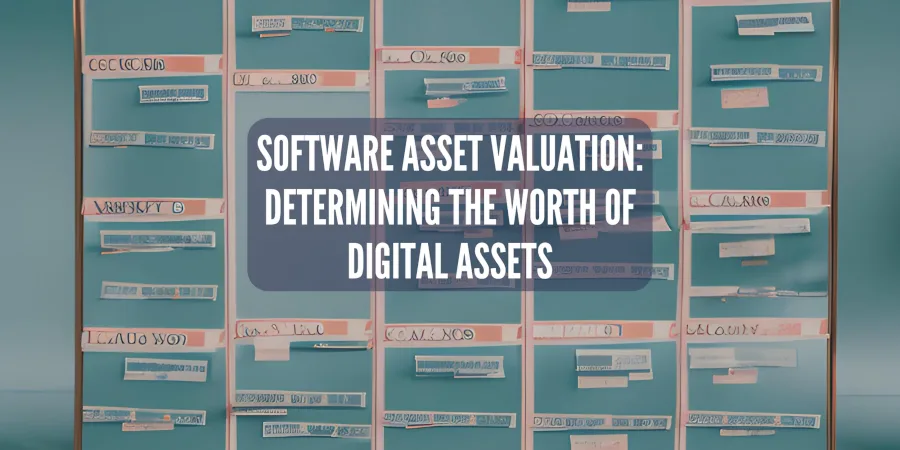In today’s rapidly evolving digital economy, software assets have become integral to the success of businesses, driving innovation, efficiency, and competitive advantage. As organizations increasingly rely on software solutions to streamline operations, enhance customer experiences, and expand their market reach, accurately valuing these digital assets has emerged as a crucial component of financial and strategic decision-making.
The purpose of this article is to delve into the realm of software asset valuation, exploring different approaches, methodologies, and factors that organizations must consider when determining the worth of their digital assets. By providing a comprehensive overview of software asset valuation practices, we aim to equip businesses, particularly mid-size and large companies, with the knowledge and insights necessary to make informed and prudent decisions regarding their software investments.
Within this article, we will begin by establishing a clear understanding of what constitutes a software asset, highlighting its key characteristics and components. We will then delve into the various factors that influence the valuation of software assets, including functional and technical considerations, market and industry dynamics, and intellectual property implications. Understanding these factors is essential for gaining a holistic view of a software asset’s worth.
To effectively determine the value of software assets, we will explore different valuation methodologies. We will discuss cost-based approaches, such as the historical cost method and replacement cost method, as well as income-based approaches like the income capitalization method and discounted cash flow method. Additionally, we will examine market-based approaches, such as the comparable transactions method and market multiples method, which leverage market data and comparable software asset transactions.
It is important to acknowledge that valuing software assets poses unique challenges due to the rapidly evolving nature of technology, licensing complexities, and emerging software delivery models such as Software as a Service (SaaS). We will discuss these challenges and consider the legal, regulatory, and security aspects that organizations must navigate during the valuation process.
To illustrate the practical application of software asset valuation, we will present case studies that showcase valuation approaches in real-world scenarios. These cases will encompass valuing internally developed software solutions, valuing software assets for acquisition or sale, and valuing software assets for financial reporting purposes.
Throughout this article, we will emphasize best practices for software asset valuation, including meticulous documentation, regular reassessment of valuations, engaging expert opinions, and conducting due diligence during mergers and acquisitions. By adhering to these practices, organizations can enhance the accuracy and reliability of their software asset valuations, enabling better decision-making.
The valuation of software assets is a critical process that empowers businesses to assess the true worth of their digital investments. By understanding the methodologies, factors, and challenges associated with software asset valuation, companies can optimize resource allocation, evaluate potential acquisitions, and effectively leverage their software assets to achieve strategic objectives. In an era defined by digital innovation, software asset valuation serves as a compass, guiding organizations towards optimal financial and strategic outcomes.
- Understanding Software Assets
- Factors Influencing Software Asset Valuation
- Valuation Methodologies
- Challenges and Considerations
- Some Case Studies: Valuation Approaches in Practice
- Best Practices for Software Asset Valuation
- Conclusion

Understanding Software Assets
To embark on the journey of software asset valuation, it is essential to establish a clear understanding of what software assets entail. In today’s digital landscape, software assets encompass a wide range of applications, programs, and systems that facilitate business operations, automate processes, and enable data-driven decision-making.
Software assets can take various forms, including commercial off-the-shelf (COTS) software, custom-built applications, open-source solutions, and cloud-based software services. They can be classified into categories such as enterprise resource planning (ERP) systems, customer relationship management (CRM) software, data analytics platforms, and industry-specific applications tailored to unique business needs.
Key characteristics and components differentiate software assets from other tangible or intangible assets. These include the functionality and features embedded within the software, the underlying technical quality and architecture, scalability and performance capabilities, and the potential for integration with other systems and applications. Understanding these characteristics and components provides a foundation for assessing the value and impact of software assets.
Factors Influencing Software Asset Valuation
Valuing software assets requires careful consideration of various factors that influence their worth. These factors can be broadly categorized into functional and technical considerations, market and industry dynamics, and intellectual property implications.
Functional and technical considerations encompass the features, functionalities, and capabilities of the software asset. The value of a software asset increases as it offers robust functionality, intuitive user experiences, scalability to accommodate growing user bases, and the ability to adapt to evolving business needs. Technical aspects, such as the quality of the software’s codebase, architecture, and adherence to industry standards, also play a crucial role in assessing the asset’s worth.
Market and industry factors provide context and determine the market demand and competitive landscape for the software asset. An asset’s value is influenced by the size and growth potential of the target market, the presence of competitors offering similar solutions, and the alignment of the asset with emerging industry trends and customer preferences. Evaluating these factors enables organizations to gauge the market viability and growth prospects of their software assets.
Intellectual property considerations play a vital role in software asset valuation. Intellectual property rights, such as patents, copyrights, and trademarks, can confer competitive advantages and enhance the value of software assets. Understanding the legal protection surrounding the software, the presence of licensing agreements or restrictions, and any potential risks of intellectual property infringement is essential for accurately assessing the asset’s worth.

Valuation Methodologies
Valuation methodologies serve as the compass for assigning a monetary value to software assets. Different approaches can be employed, depending on the specific circumstances and requirements of the valuation. The three primary valuation methodologies for software assets are cost-based approaches, income-based approaches, and market-based approaches.
Cost-based approaches determine the value of a software asset based on the costs incurred in its development or acquisition. The historical cost method considers the actual expenses incurred during the asset’s creation, including personnel costs, development tools, and infrastructure. The replacement cost method evaluates the expenses required to develop or acquire a similar software asset in the current market. The market-based cost method leverages market data to estimate the market value of comparable software assets.
Income-based approaches focus on the future income generation potential of the software asset. The income capitalization method assesses the present value of expected future cash flows generated by the asset over its useful life, applying appropriate discount rates. The discounted cash flow method calculates the net present value of projected future cash flows, considering factors such as revenue streams, operating costs, growth rates, and risk factors.
Market-based approaches rely on the analysis of comparable transactions or market multiples to derive the value of software assets. The comparable transactions method examines the prices paid for similar software assets in recent transactions to gauge the asset’s value. The market multiples method utilizes key financial metrics, such as revenue multiples or earnings multiples of comparable companies in the software industry, to estimate the value of the software asset being valued.
Challenges and Considerations
Valuing software assets comes with its own set of challenges and considerations that organizations must address. The dynamic nature of technology poses complexities in accurately assessing the value of software assets. Rapid advancements in software development techniques, emerging programming languages, and evolving architectural paradigms require constant vigilance and expertise to stay up-to-date with the latest trends and methodologies.
The evolving landscape of software licensing models also presents challenges in valuation. Traditional perpetual licenses, subscription-based models, and the rise of Software as a Service (SaaS) introduce complexities in determining the appropriate revenue recognition and assessing the impact on the asset’s value. Understanding the nuances of different licensing models and their implications is essential for an accurate valuation.
Legal and regulatory factors must be considered during software asset valuation. Organizations need to ensure compliance with software licensing agreements, which often have specific usage restrictions, renewal terms, and penalties for non-compliance. Furthermore, navigating intellectual property protection and infringement risks is critical to mitigate legal and financial liabilities associated with software assets.
Data privacy and security concerns add another layer of complexity to software asset valuation. The increasing emphasis on data protection regulations, such as the General Data Protection Regulation (GDPR) and the California Consumer Privacy Act (CCPA), necessitates careful assessment of a software asset’s compliance with these regulations. Data breaches and security vulnerabilities can significantly impact the value of software assets, as they can erode customer trust and lead to reputational damage.

Some Case Studies: Valuation Approaches in Practice
To illustrate the practical application of software asset valuation methodologies, let us examine a few case studies. These real-world scenarios demonstrate how different valuation approaches are employed in specific contexts:
1. Case Study 1: Valuing an Internally Developed Software Solution
In this case, a company has developed a custom software solution to streamline its supply chain operations. The valuation would involve assessing the costs incurred in the development process, analyzing the functionality and technical quality of the software, and estimating the potential cost savings or revenue enhancements it brings to the organization.
2. Case Study 2: Valuing a Software Asset for Acquisition or Sale
In the context of a merger or acquisition, valuing a software asset becomes crucial to determine its fair market value. This would involve assessing market comparables, analyzing the financial performance and growth potential of the asset, and considering any intellectual property rights or licensing agreements associated with it.
3. Case Study 3: Valuing a Software Asset for Financial Reporting Purposes
For financial reporting purposes, organizations need to determine the fair value of software assets to ensure accurate representation on their balance sheets. This requires applying appropriate valuation methodologies, considering any impairment indicators, and complying with relevant accounting standards such as the International Financial Reporting Standards (IFRS) or the Generally Accepted Accounting Principles (GAAP).
Best Practices for Software Asset Valuation
To enhance the accuracy and reliability of software asset valuation, organizations should follow certain best practices:
A. Thorough Documentation and Record-Keeping: Maintain comprehensive documentation of software development costs, licensing agreements, intellectual property rights, and any other relevant information to provide a clear audit trail of the asset’s value.
B. Regularly Reassessing and Updating Valuations: Given the dynamic nature of software assets, regular reassessment of their value is essential. Periodically review and update valuations to reflect changes in market conditions, technological advancements, or shifts in the organization’s strategic priorities.
C. Engaging Expert Opinions and Third-Party Appraisals: Seek expertise from professionals specializing in software asset valuation, who can provide unbiased opinions and assist in conducting thorough appraisals. Their knowledge and experience can enhance the accuracy and reliability of the valuation process.
D. Conducting Due Diligence in Acquisitions and Mergers: When acquiring or merging with a company, conducting thorough due diligence is crucial to understand the value and risks associated with the software assets involved. This includes assessing the legal and intellectual property aspects, conducting technical assessments, and evaluating the compatibility of the software assets with existing systems.
Conclusion
Valuing software assets is a multifaceted process that requires careful consideration of functional, technical, market, and intellectual property factors. By employing appropriate valuation methodologies, organizations can gain insights into the worth of their digital assets, enabling informed decision-making for financial and strategic objectives.
As software continues to shape and transform industries, it is imperative for companies to prioritize accurate software asset valuation. By addressing the challenges and complexities involved, adhering to best practices, and staying attuned to evolving technology trends, organizations can navigate the valuation process effectively.
Looking ahead, software asset valuation will remain a critical aspect of financial and strategic decision-making. As technology advances and the digital landscape evolves, organizations must adapt their valuation approaches to capture the true worth of their software assets. By doing so, they can unlock the full potential of their digital investments and drive sustainable growth in the dynamic digital economy.
